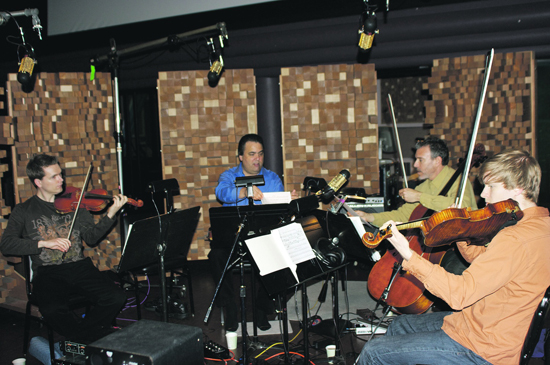
| ||||||
The Grammy-winning string quartet, known for its genre-defying mastery of everything from classical to bluegrass, swing to hip-hop, latin american music to jazz, and now, rock, easily defies description. Sometimes referred to as an "American string quartet," Turtle Island is more like an "Everything string quartet."
The ensemble's latest release, Have You Ever Been...?, opens an alternate universe for music lovers: one where highly-trained classical artists, steeped in the improvisational traditions of jazz, embrace the genius of Hendrix.
Balakrishnan, in a wide-ranging interview, talks about his fellow quartet members, Turtle Island's history, his own compositions, winning awards, and the undisputed king of electric guitar, Hendrix.
Listening to Hendrix as a teenager in the 1970's inspired Balakrishnan to pick up a guitar himself. "Playing guitar taught me how to play the blues," he says. "When I went back to the violin, I found you can play more percussive sounds on it too. It made me widen the performance practice of my instrument."
Approximately forty years later, a Woodstock video of Hendrix's brilliant 1969 performance triggered a long-buried yearning in Balakrishnan's soul. "There's always pressure to repeat yourself when you've been successful," he says, about the period of time following the release of A Love Supreme, which won the group its second Grammy in 2008. "But I didn't want to do that. So I listened to (Hendrix's) Electric Ladyland without talking to anybody about it. I kept it under my hat - didn't even tell the band - because I knew everyone would jump on the commercial idea of it."
At the same time, Balakrishnan was developing his Tree of Life, a one-hour collaborative work involving scientists and artists and based on Darwin's evolutionary theories. "I realized Hendrix and Tree of Life were my story. The connection lies in me, not in a marketing plan. It's a fortuitous combination: the two ideas grew up with each other."
And with that, a CD was born. "You could say I've been writing the same piece all my life," Balakrishnan says, turning the conversation to process. "I limit myself to sounds through which I can draw lines of continuity."
Sounding anything but limited, he continues: "I like a wide swath. Honestly, what I do, is just play my violin, then go write it down." Moments later, he's on a reverse curve, saying, "I understand the need for good architecture. There's no reason for contemporary musicians to abandon the elements and principles of classical music." He's rather Beethovian in his compositional constructions: outlining the overall form, calculating the weight-bearing load on the listener's ear, eliminating excess. It's a far cry from the "play it and write" he first describes.
Testing the limits might be a Turtle Island signature. "This is the kind of music you choose by nature," says Balakrishnan. "Some people do one thing all the way. Others, find a wide-range and go for connections between things."
Mark Summer has been with Turtle Island from its debut 25 years ago. "He's the premier crossover cellist on the planet," Balakrishnan says. "He's a cello, and a bass, and drums. He's a one man rhythm section."
Quartet member Mads Tolling appears to be an equally miraculous violinist. "Mads grew up listening to Keith Jarrett and Miles Davis. He has less of a fiddle style and more of the purity of the fine European players," Balakrishnan says. "And Jeremy," he says, referring to new member Jeremy Kittel, "he grew up in the alternative tradition. He's special because he plays in an instinctive, grounded way."
String quartets and "down to earth" don't usually appear in the same sentence, let alone the same ensemble, but Turtle Island has never been usual. Their insatiable appetite for performing adds up to a blistering 50 performance gigs a year. Outreach is huge too, according to Balakrishnan. "It's about sharing the craft with the community," he says. While bemoaning YouTube for "creating a glut, where, instead of things happening and then disappearing, they stay and stay," he applauds the online video-sharing site for its "immediate access."
To young musicians, he offers advice. "It's important you don't close off possibilities for your instrument. Don't run away from classical traditions, find your own style, and go deep."
Like Beethoven's endings, finishing an interview with Balakrishnan isn't simple. He tosses out tantalizing, last-second comments, ("Half the importance of a string quartet is the composer, but people don't know it-" and, "I like a honking Hendrix chord; it stretches a listener's psyche,") before admitting he's late for lunch. It's a conversation cut short, leaving plenty of food for thought.
Reach the reporter at:
Copyright
